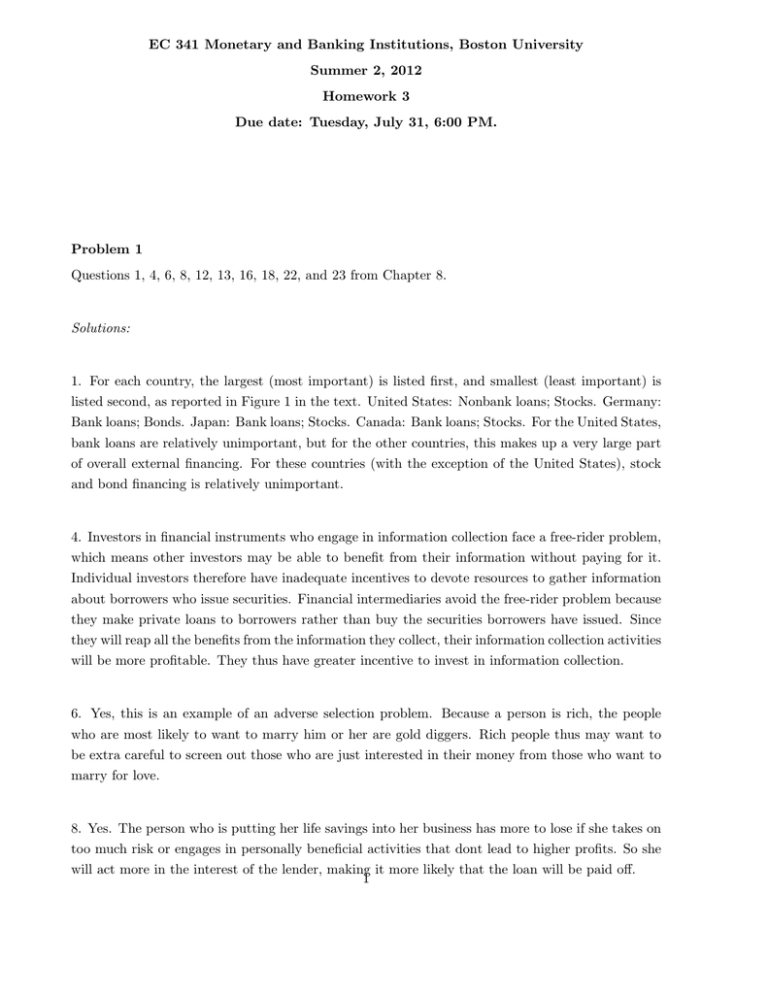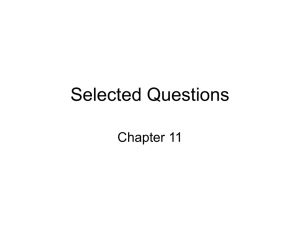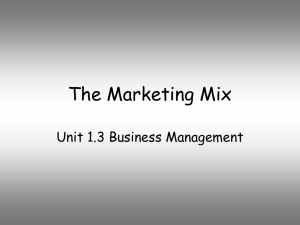EC 341 Monetary and Banking Institutions, Boston University Summer 2, 2012
advertisement

EC 341 Monetary and Banking Institutions, Boston University Summer 2, 2012 Homework 3 Due date: Tuesday, July 31, 6:00 PM. Problem 1 Questions 1, 4, 6, 8, 12, 13, 16, 18, 22, and 23 from Chapter 8. Solutions: 1. For each country, the largest (most important) is listed first, and smallest (least important) is listed second, as reported in Figure 1 in the text. United States: Nonbank loans; Stocks. Germany: Bank loans; Bonds. Japan: Bank loans; Stocks. Canada: Bank loans; Stocks. For the United States, bank loans are relatively unimportant, but for the other countries, this makes up a very large part of overall external financing. For these countries (with the exception of the United States), stock and bond financing is relatively unimportant. 4. Investors in financial instruments who engage in information collection face a free-rider problem, which means other investors may be able to benefit from their information without paying for it. Individual investors therefore have inadequate incentives to devote resources to gather information about borrowers who issue securities. Financial intermediaries avoid the free-rider problem because they make private loans to borrowers rather than buy the securities borrowers have issued. Since they will reap all the benefits from the information they collect, their information collection activities will be more profitable. They thus have greater incentive to invest in information collection. 6. Yes, this is an example of an adverse selection problem. Because a person is rich, the people who are most likely to want to marry him or her are gold diggers. Rich people thus may want to be extra careful to screen out those who are just interested in their money from those who want to marry for love. 8. Yes. The person who is putting her life savings into her business has more to lose if she takes on too much risk or engages in personally beneficial activities that dont lead to higher profits. So she will act more in the interest of the lender, making it more likely that the loan will be paid off. 1 12. Information asymmetries are also present in government bond markets. Usually investors resort to many information sources about the characteristics of particular governments to assess their ability or willingness to honor their debt. As the Argentinean case illustrates, sometimes this lack of information results in huge losses for bondholders. In this respect, the problem is not significantly different from an investor who decides which corporate bond to buy, although it may be fair to say that information about corporate bonds is more standardized (making it easier to compare firms). After the Argentinean default, investors were willing to buy bonds issued by its government only at a significant risk premium, making it very costly for Argentina to raise funds in bond markets. 13. The free-rider problem means that private producers of information will not obtain the full benefit of their information-producing activities, and so less information will be produced. This means that there will be less information collected to screen out good from bad risks, making adverse selection problems worse, and that there will be less monitoring of borrowers, increasing the moral hazard problem. 16. Smaller firms that are not well known are the most likely to use bank financing. Because it is harder for investors to acquire information about these firms, it will be hard for the firms to sell securities in financial markets. Banks that specialize in collecting information about smaller firms will then be the only outlet these firms have for financing their activities. 18. True. If the borrower turns out to be a bad credit risk and goes broke, the lender loses less, because the collateral can be sold to make up any losses on the loan. Thus adverse selection is not as severe a problem. 22. You are willing to pay the average price. If the distribution of car values is symmetric, you are willing to pay $22,000 for a randomly selected car. 23. You are willing to pay the average price up front: $22,000. However, the dealer will know this, and only sell you a car worth between $20,000 and $22,000. But you know this. So you will only pay $21,000. And so on. This ends with you paying $20,000, and the car being worth $20,000. This is OK for you, but the dealer can never sell cars worth more than $20,000. The resolution, of course, is to get more information. This may include a test drive, mechanical inspection, warranty, etc. Problem 2 Questions 1, 2, 3, 4, 12, 13, 14, 15, 18, 21, 23, and 25 from Chapter 9. 2 Solutions: 1. Asymmetric information problems (adverse selection and moral hazard) are always present in financial transactions but normally do not prevent the financial system from efficiently channeling funds from lender-savers to borrowers. During a financial crisis, however, asymmetric information problems intensify to such a degree that the resulting financial frictions lead to flows of funds being halted or severely disrupted, with harmful consequences for economic activity. 2. When an asset-price bubble bursts and asset prices realign with fundamental economic values, the resulting decline in net worth means that businesses have less skin in the game and so have incentives to take on more risk at the lenders expense, increasing the moral hazard problem. In addition, lower net worth means there is less collateral and so adverse selection increases. The bursting of an asset-price bubble therefore makes borrowers less credit-worthy and causes a contraction in lending and spending. The asset price bust can also lead to a deterioration in financial institutions balance sheets, which causes them to deleverage, further contributing to the decline in lending and economic activity. 3. An unanticipated decline in the price level leads to firms real burden of indebtedness increasing while there is no increase in the real value of their assets. The resulting decline in firms net worth increases adverse selection and moral hazard problems facing lenders, making it more likely a financial crisis will occur in which financial markets do not work efficiently to get funds to firms with productive investment opportunities. 4. A decline in real estate prices lowers the net worth of households or firms that are holding real estate assets. The resulting decline in net worth means that businesses have less at risk and so have more incentives to take on risk at the lenders expense. In addition, lower net worth means there is less collateral and so adverse selection increases. The decline in real estate prices can thus make borrowers less credit-worthy and cause a contraction in lending and spending. The real estate decline can also lead to a deterioration in financial institutions balance sheets, which causes them to deleverage, further contributing to the decline in lending and economic activity. 12. Answers may vary. In general, it is believed that the country as a whole probably learned from the experience of the Great Depression, and have put in place more sophisticated policy frameworks to help deal with severe economic downturns more effectively. For instance, bank panics, which were widespread during the Great Depression, were virtually nonexistent during the 20072009 crisis; this is probably due to bank accounts now being insured by the FDIC, when they were not during the Great Depression. Another factor seems to be the resolve by policymakers not to make the same mistakes made during the Great Depression by instituting more aggressive, swifter policies to avoid 3 any contagion effects that would unnecessarily deepen or lengthen the crisis. 13. The use of data mining to give households numerical credit scores which can be used to predict defaults and the use of computer technology to bundle together many small mortgage loans and cheaply package them into securities. Together both enable the origination of subprime mortgages, which then can be sold off as securities. 14. Because the agent for the investor, the mortgage originator, has little incentive to make sure that the mortgage is a good credit risk. 15. False. Financial engineering may create financial products that are so complex that it can be hard to value the cash flows of the underlying assets for a security or to determine who actually owns these assets. In other words, the increased complexity of structured products can actually destroy information, thereby making asymmetric information worse in the financial system and increasing the severity of adverse selection and moral hazard problems. 18. During a financial crisis, asset prices fall, oftentimes very rapidly and unexpectedly. This leads to the expectation that asset prices may fall further in the future, and increases the uncertainty over the value of assets put up as collateral. As a result, firms accepting collateral assets require larger and larger haircuts, or discounts on the value of collateral in expectation of future lower values. This requires firms to put up increasingly more collateral for the same loans over time. Due to the falling asset prices and rising haircuts, it becomes a buyers market for these rapidly falling assets; any firms needing to raise funds quickly would then be forced to sell assets at a fraction of their original worth. 21. Because in advanced countries, debt is usually long term. When the price level falls real indebtedness increases, lowering net worth and increasing adverse selection and moral hazard problems. In emerging market countries, debt tends to be very short-term so that a decline in the price level does not raise real indebtedness very much because the debt is repriced so frequently. 23. This is primarily due to liability dollarization in which financial firms issue debt denominated in dollars (or another stable currency). Thus, when there is a currency crisis and the currency collapses, indebtedness in terms of domestic currency increases, leading to banks and other borrowing financial firms not being able to pay back loans. The resulting loan losses at creditor banks cause them to fail, creating a banking crisis. Hence a currency crisis and a banking crisis go hand in hand. 25. When the banking system is in trouble, the government and central bank are now between a 4 rock and a hard place: If they raise interest rates too much, they will destroy their already weakened banks, and if they dont, they cant maintain the value of their currency. Once market participants recognize this, they know that the government cant defend its currency so they have a one-way bet and pile on, selling the currency, leading to a speculative attack and a currency crisis. Problem 3 Questions 1, 2, 7, 15, 23, 24, and 25 from Chapter 10. Solutions: 1. Because if the bank borrows too frequently from the Fed, the Fed may restrict its ability to borrow in the future. 2. The rank from most to least liquid is (c), (b), (a), (d). 7. To lower capital and raise ROE, holding its assets constant, it can pay out more dividends or buy back some of its shares. Alternatively, it can keep its capital constant, but increase the amount of its assets by acquiring new funds and then seeking out new loan business or purchasing more securities with these new funds. 15. False. Although diversification is a desirable strategy for a bank, it may still make sense for a bank to specialize in certain types of lending. For example, a bank may have developed expertise in screening and monitoring borrowers for a particular kind of loan, thus improving its ability to handle problems of adverse selection and moral hazard. 23. ROE = ROA x EM 0.15 = 0.01 x EM EM = 15 = assets/equity So equity/assets = 6.66%. This is a well-capitalized bank. 24. The assets fall in value by $8 million (= $100 million x -2% x 4 years) while the liabilities fall in value by $10.8 million (= $90 million x -2% x 6 years). Because the liabilities fall in value by $2.8 million more than the assets do, the net worth of the bank rises by $2.8 million. The interestrate risk can be reduced by shortening the maturity of the liabilities to a duration of four years or lengthening the maturity of the assets to a duration of six years. Alternatively, you could engage in an interest-rate swap, in which you swap the interest earned on your assets with the interest on another banks assets that have a duration of six years. 5 25. The gap is $10 million ($30 million of rate-sensitive assets minus $20 million of rate-sensitive liabilities). The change in bank profits from the interest rate rise is +$0.5 million (5% x $10 million); the interest-rate risk can be reduced by increasing rate-sensitive liabilities to $30 million or by reducing rate-sensitive assets to $20 million. Alternatively, you could engage in an interestrate swap in which you swap the interest on $10 million of rate-sensitive assets for the interest on another banks $10 million of fixed-rate assets. 6







